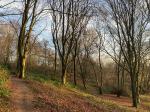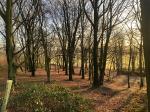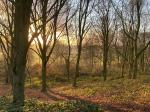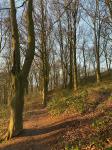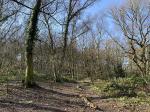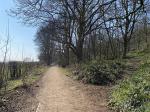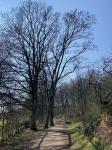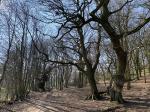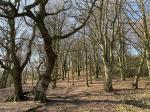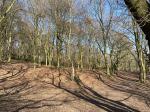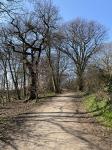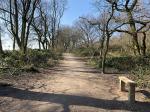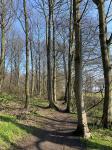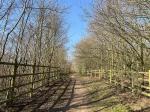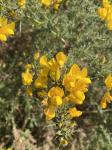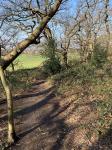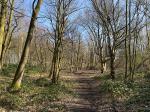Brayton Barff Through the Seasons.
Set in the Vale of York, South West of the market town of Selby and between the villages of Thorpe Willoughby and Brayton, lies Brayton Barff, a sandstone Hill approximately one hundred and fifty feet in height which was formed by glacial movement during the last Ice Age. It is a significant landmark in an otherwise flat landscape.
Today the site is primarily owned by Yorkshire Water with Selby District Council owning a small patch of the land adjacent to the A63 Selby bypass. A large underground reservoir occupies the centre of the site which delivers water to around 4.7 million customers throughout Yorkshire.
Within the Barff woodland over 40% of the trees are Sessile Oak which are generally found in semi natural woodlands in the north of the country. These trees are so called because its acorns are not held on stalks, like those of the English Oak (Pedunculate), but attached directly to the outer twigs. There are also several English Oak trees as well as some cross-hybrid oaks. These trees are known to support many species of flora and fauna, invertebrates, mosses, lichen and fungi.
During the Victorian times it is thought that the shipbuilders on the east coast would come over to the Barff for selected cuts of timber to build their sea going vessels.
The Barff also has a variety of other trees including Silver Birch, Beech, Sycamore, Holly, Rowan, Scots Pine, Alder, Hawthorne and European Larch. There are also several Yew, Willow, Hazel, Horse Chestnut and Wych Elm. As with similar woodlands there are a variety of bushes, including Honeysuckle, Elderberry, Gorse, Broom and Buddleia.
The history of Brayton Barff is quite vague, apparently during 1803 a beacon was lit on the Barff when the country was threatened with an invasion by Napoleon. In May 1935, to celebrate King George V's Silver Jubilee, a Bonfire was lit on the Barff as part of the celebrations.
Early issues of Ordnance Survey Maps dated 1903 clearly show a rifle range on the Barff, extending out to Mill Lane. During the 
Between 2001 – 2004 the A63 Selby bypass, 10km twin lane single carriageway was constructed which severed the South West corner of the Barff, adjacent to Selby Golf Course and resulted in a slight redesign of several holes on the golf course. Wooden fencing was erected as a result of this new road running alongside of the Barff and a footbridge constructed over the ‘new road’ following the line of the Bridal way which extends from Mill Lane. Around 2005/2006 a definite 2metre wide limestone aggregate footpath was laid forming a circular path around the outer edges of the woodland. This footpath is approximately 1.2 miles in length and takes about 30 minutes to circumnavigate at a leisurely pace.
In 2012 the Barff was declared an Ancient Oak Woodland and as such throughout 2012 and 2013 significant work had been carried out by the relevant agencies to cut and remove large swathes of non-native trees, creating at that time huge scars on the landscape. Some three years later the planting of the native trees have become well established and are flourishing. Ongoing maintenance work on the footpath around the bottom of the Barff was completed during the Summer of 2016.
A second phase of woodland maintenance commenced during the Autumn of 2019 with the removal of many old and diseased trees and the cutting back of the Gorse and Broom bushes, especially adjacent to the ‘bypass trail’, this work continued through till March 2020 with re planting continuing into April 2020.
Brayton Barff is a popular site for walkers and bird watchers alike and a path circling the outer perimeter of the Barff makes a pleasant thirty minute walk, giving views looking over towards Selby and the village of Brayton as well as the power stations of Drax and Eggborough..jpg)
For the early risers it is a great place to see some stunning sunrises over the villages of Brayton looking towards Drax Power Station, the same with the Sunsets looking over towards Eggborough and Monk Fryston.
The Barff changes with the Seasons and every visit can reveal something new, the woodland is a haven for wildlife. Records show that since 1982 one hundred and twelve species of bird have been seen in the woodland and at least 40 of those have bred here, including Tawny Owl, Buzzard, Green Woodpecker, Spotted Flycatcher, Goldcrest and Nuthatch to name just a few. On average over 70 species of bird are recorded each year. Further details of the bird life on the Barff can be found on the Brayton Barff Group Facebook page, especially the posts from Derek Cooper. Today ‘The Friends of Brayton Barff group’ led by Derek and a small team of volunteers help keep and maintain the cleanliness of the site as well as recording the wildlife and bird sightings.
The Barff is also home to fifteen different species of mammals, including Muntjac Deer, Pipistrelle Bat, Fox, and Field Vole.
Over eighty species of plant and wildflowers have been recorded, included Bee Orchid, Northern Marsh Orchid, Wood Anemone, Marsh Ragwort, Bluebell, White Bluebell, Bittersweet and Purple and White Foxgloves. Over twenty species of Butterfly have been recorded, including Marbled White, Brown Angus, Speckled Wood, Comma and Brimstone.
During the Autumnal months fungi thrives in this woodland environment, species including Fly Agaric, Beefsteak Tree Fungi, Chicken of the Wood, Sulphur Tufts, Stinkhorn, Ink cap, Puffballs and Hoof Bracket are just some of the many varieties that can be found here.
Click on the galleries shown below to expand the albums.
March 2022
I had to keep reminding myself that we are just coming out of Winter.
The meteorological spring actually starts on the 1st March and runs through to the 31st May, though the first day of spring in the astronomical calendar begins on the vernal equinox, 20 March 2022. So whatever you think, I always regard Spring being here once the Daffodils start to come into flower.
So far, this winter though it has been quite mild and drier than average. The beginning of the month started quite wet with early morning temperatures averaging at 3-4C, and the odd early morning frost occasionally catching us out. Towards the middle of the month the weather turned for the better and from the 21st – 27th we were able to enjoy daily afternoon temperatures of 18C. (Many parts of Southern Spain were experiencing torrential rain and flooding at this time) The pleasant warm afternoons and cold evenings always meant some misty mornings the following day. The warm weather came to an abrupt halt though on Monday 28th when the daytime temperature dropped significantly and brought with it some cold and wet rain showers for the next three days, culminating on the early hours of Thursday 31st with our first snow of the winter, fortunately we just received a light dusting of snow on the Barff.
It is nice that the spring mornings are getting quite light now and no need for the head torch on my morning rambles, even after the clocks went forward on the 27th it was still quite light at 7.00am, though quite cool at times, I’m still having to wear my winter fleece and occasionally swap it for the waterproof jacket.
Everything is growing at a pace now in the woodland, our wildflowers are shooting up around the Barff and especially alongside the perimeter footpath, Wild Garlic, Wood Sorrell and Wood Sage to name just a few. As the month comes to a close, I’m noticing one or two Bluebells just beginning to come into flower, though it will be Easter time, mid-April before we see a significant change. The trees and bushes are beginning to awake after their winter break, with tiny shoots and buds appearing, Oak trees are well in bud as are the Beach and Silver Birch trees, Mountain Ash/Rowan tree buds are opening and tiny leaves beginning to appear. Elderberry bushes and Bramble are growing apace too.
March is an exciting time for the bird life on the Barff, our resident birds like the Greater Spotted Woodpecker are busy preparing their nest sites for the breeding season, they can be heard frequently drumming on the tree trunks. Nuthatches have been quite vocal too, I have heard and watched at three at different locations on the woodland, Bluetits and Great Tits can be seen most days as can the Long-tailed tits, especially around the feeding stations. By the middle of the month the Chiffchaffs had returned for their summer vacation on the Barff, though with the ‘milder winters’ of late, I think many are now over wintering in this country. I always enjoy watching and listening to the Buzzard as it flies overhead, its distinctive squawk is quite noticeable through the trees. It’s nice to see the female Sparrowhawk in its usual haunt, getting ready for the breeding season.
I have heard lots of Dunnock of late on the Barff, along with the wrens and Robins. I don’t usually associate Reed Buntings with the Barff, though it is probably due to the fact I have not seen many of them, but recently I have been picking them out quite often, their little moustaches giving their appearance away.
I managed several afternoon walks during the warmer weather and was surprised to see a fair selection of Butterflies feeding on the blossom including Small Tortoiseshell, Peacock and Orange Tips, lets hope once the warmer weather comes along we will be seeing a lot more of them.
|

